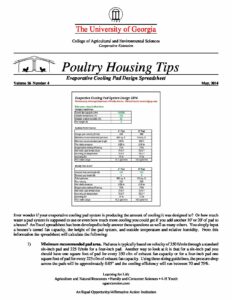Ever wonder if your evaporative cooling pad system is producing the amount of cooling it was designed to? Or how much water a pad system is supposed to use or even how much more cooling you could get if you add another 10' or 20' of pad to a house? An Excel spreadsheet has been developed to help answer these questions as well as many others. You simply input a houses’s tunnel fan capacity, the height of the pad system, and outside temperature and relative humidity. From this information th...e spreadsheet will calculate the following:
1) Minimum recommended pad area. Pad area is typically based on velocity of 350 ft/min through a standard six-inch pad and 225 ft/min for a four-inch pad. Another way to look at it is that for a six-inch pad you should have one square foot of pad for every 350 cfm of exhaust fan capacity or for a four-inch pad one square foot of pad for every 225 cfm of exhaust fan capacity. Using these sizing guidelines, the pressure drop across the pads will be approximately 0.05" and the cooling efficiency will run between 70 and 75%.
2) Minimum recommended pad length. Minimum recommended pad area divided by the height of the pad inputted.
3) Pad static pressure. The pad pressure is essentially a measure of the work/pressure required to pull air through the pad at the desired air velocity (350ft/min for a six-inch pad, 225 ft/min for a four-inch pad). The higher the pressure, the greater amount of work required by the fans to pull air through the pads. The pad pressure tends to increase over time as the pads become dirty. Pad pressure is just a portion of the total pressure, which includes inlet/door pressure, transition pressure, and pipe pressure. The total pressure will tend to be between 0.10 and 0.20, depending on a variety of factors. For more details please refer to Poultry Housing Tips, “Measuring Static Pressure in Tunnel-Ventilated Houses” (Vol. 22, No. 9) and/or Poultry Housing Tips, “Tunnel Air speed/Static Pressure Estimating Spreadsheet” (Vol. 24, No. 5) both of which are available at www.poultryventilation.com.
4) Evaporative cooling efficiency. A pad’s evaporative cooling efficiency is essentially a measure of how effective a pad is at saturating the incoming air with moisture. A pad with a 100% efficiency would saturate the incoming air with moisture, resulting in maximum evaporative cooling but would also result in an incoming relative humidity of 100%. Pad systems are typically designed to operate at a cooling efficiency between 70 and 80%. The cooling efficiency is less than 100% to keep the incoming relative humidity from becoming excessive (typically between 75 and 85%).
5) Wet bulb/pad temperature. Wet bulb temperature is the lowest temperate achievable through the use of evaporative cooling. The lower the wet bulb temperature the drier the air and the more effective an evaporative cooling system will be at reducing the incoming air temperature. When water circulates over a pad system it will quickly reach the wet bulb temperature.
6) Incoming air temperature. The temperature of the air after it passes through the evaporative cooling pad system.
7) Incoming relative humidity. The relative humidity of the air after it passes through the evaporative cooling pad system.
8) Pad water usage. The amount of water that will evaporate from a pad system each minute under the conditions given.
The spreadsheet also provides an option to change the pad system length and width and see how the output variables change.
The spreadsheet results can vary slightly from what one might see in the field. There can be some error associated with the psychometric equations used to calculate the output variables, the cooling efficiency/static pressure of a pad system can change with age, and the spreadsheet assumes that the pads are throughly wetted. Regardless, the spreadsheet can provide the user with valuable information on how the performance of a pad system will change with changes in outside temperature and relative humidity as well as overall pad area.
This spreadsheet, along with others, can be found at https://www.poultryventilation.com/spreadsheets.
Details
| Year | Volume | Number | Categories |
|---|---|---|---|
| 2014 | 26 | 4 |

